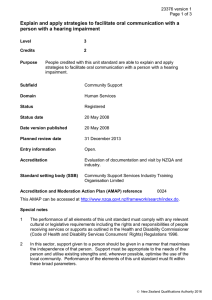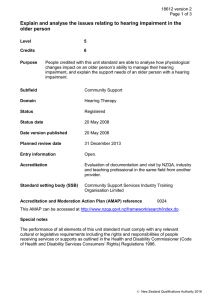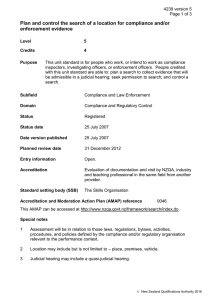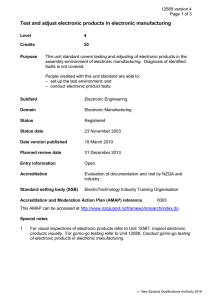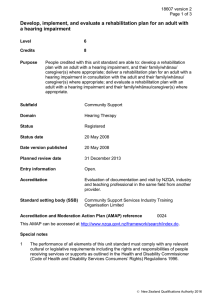Teach an adult with a hearing impairment and associated others... communication strategies
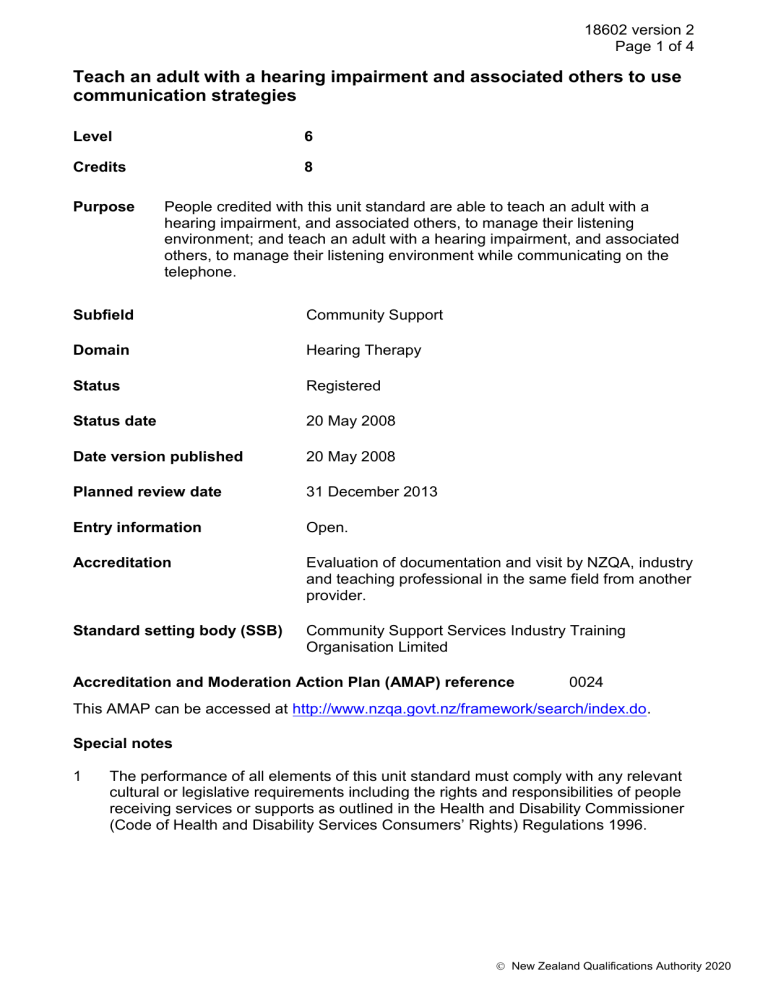
18602 version 2
Page 1 of 4
Teach an adult with a hearing impairment and associated others to use communication strategies
Level 6
Credits 8
Purpose People credited with this unit standard are able to teach an adult with a hearing impairment, and associated others, to manage their listening environment; and teach an adult with a hearing impairment, and associated others, to manage their listening environment while communicating on the telephone.
Subfield Community Support
Domain
Status
Status date
Date version published
Hearing Therapy
Registered
20 May 2008
20 May 2008
Planned review date
Entry information
31 December 2013
Open.
Accreditation Evaluation of documentation and visit by NZQA, industry and teaching professional in the same field from another provider.
Standard setting body (SSB) Community Support Services Industry Training
Organisation Limited
Accreditation and Moderation Action Plan (AMAP) reference 0024
This AMAP can be accessed at http://www.nzqa.govt.nz/framework/search/index.do
.
Special notes
1 The performance of all elements of this unit standard must comply with any relevant cultural or legislative requirements including the rights and responsibilities of people receiving services or supports as outlined in the Health and Disability Commissioner
( Code of Health and Disability Services Consumers’ Rights) Regulations 1996.
New Zealand Qualifications Authority 2020
18602 version 2
Page 2 of 4
2 This unit standard cannot be assessed against in a simulated environment. It is required that people seeking credit for this unit standard demonstrate competence and be assessed in the workplace. This can be through paid or unpaid employment, or in placements in a service provider workplace negotiated by an education provider.
3 An ability to integrate theory with practice in the workplace must be demonstrated.
This will call for a variety of modes of assessment and forms of evidence to show consistency of performance across a range of situations.
4 The candidate will have already determined the communication needs of the adult with a hearing impairment. These are the needs that are referred to in the performance criteria. A comprehensive case history will have been taken before teaching communication strategies and the candidate will have an awareness of whether a client has a vision impairment that will preclude the use of visual aids, for example.
5 Definition
Associated others are the people with whom the individual receiving services has regular and frequent contact. In the aural rehabilitation context this refers to most frequent communication partners may include- spouse, other family members, carers, friends, or colleagues.
Elements and performance criteria
Element 1
Teach an adult with a hearing impairment, and associated others, to manage their listening environment.
Performance criteria
1.1 The qualities of a listening environment are analysed in terms of the factors that may affect the ability of an adult with a hearing impairment to communicate effectively in that environment.
1.2 A communication strategies teaching programme is developed and the identified learning outcomes meet the communication needs of the adult and associated others.
1.3 Strategies to manage the qualities of the listening environment meet the communication needs and capabilities of the adult and associated others.
Range may include but are not limited to
– technology – use of assistive devices, hearing aids; physical environment – lighting, noise control, acoustics, seating; communication repair strategies
– repetition, confirmation, clarification, requesting and using clear speech.
1.4 Strategies are taught to the adult and associated others in a learning style that accords with their preference and cognitive ability.
New Zealand Qualifications Authority 2020
18602 version 2
Page 3 of 4
1.5 The communication strategies teaching programme is evaluated and reviewed in relation to the desired learning outcomes and actual learning outcomes.
1.6
Element 2
A plan is drawn up enabling deficiencies in the teaching programme to be rectified, if required, in accordance with the evaluation.
Teach an adult with a hearing impairment, and associated others, to manage their listening environment while communicating on the telephone.
Performance criteria
2.1 The qualities of a listening environment are examined in terms of the factors that may affect the ability of an adult with a hearing impairment, and associated others, to communicate effectively on the telephone in that environment.
2.2 A telephone communication strategies teaching programme is developed and the identified learning outcomes meet the telephone communication needs of the adult and associated others.
2.3 Strategies to manage the qualities of the telephone listening environment meet the telephone communication needs and capabilities of the adult and associated others.
Range may include, but is not limited to – technology – use of assistive devices, hearing aids; physical environment
– noise control, acoustics; communication repair strategies – repetition, confirmation, clarification, requesting and using clear speech, taking notes.
2.4 Strategies are taught to the adult and associated others in a learning style that accords with their preference and cognitive ability.
2.5 The telephone communication strategies teaching programme is evaluated and reviewed in relation to the desired outcomes and actual outcomes.
2.6 A plan is drawn up enabling deficiencies in the teaching programme to be rectified, if required, in accordance with the evaluation.
Please note
Providers must be accredited by NZQA, or an inter-institutional body with delegated authority for quality assurance, before they can report credits from assessment against unit standards or deliver courses of study leading to that assessment.
Industry Training Organisations must be accredited by NZQA before they can register credits from assessment against unit standards.
Accredited providers and Industry Training Organisations assessing against unit standards must engage with the moderation system that applies to those standards.
New Zealand Qualifications Authority 2020
18602 version 2
Page 4 of 4
Accreditation requirements and an outline of the moderation system that applies to this standard are outlined in the Accreditation and Moderation Action Plan (AMAP). The
AMAP also includes useful information about special requirements for organisations wishing to develop education and training programmes, such as minimum qualifications for tutors and assessors, and special resource requirements.
Comments on this unit standard
Please contact the Community Support Services Industry Training Organisation Limited enquiries@cssito.org.nz
if you wish to suggest changes to the content of this unit standard.
New Zealand Qualifications Authority 2020
